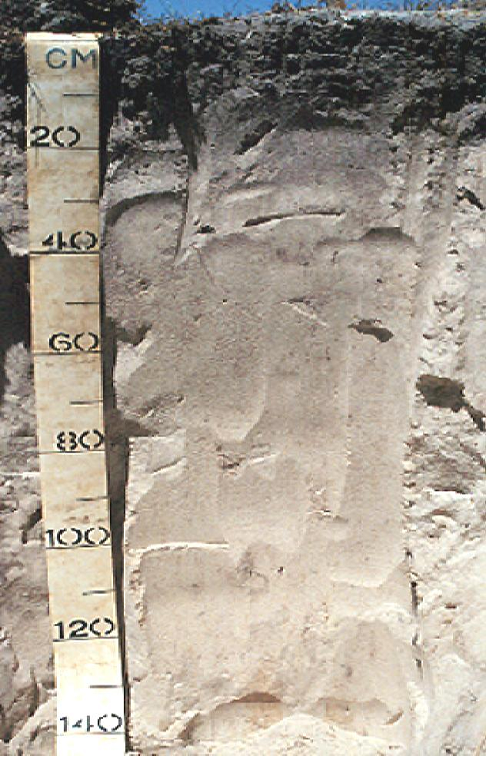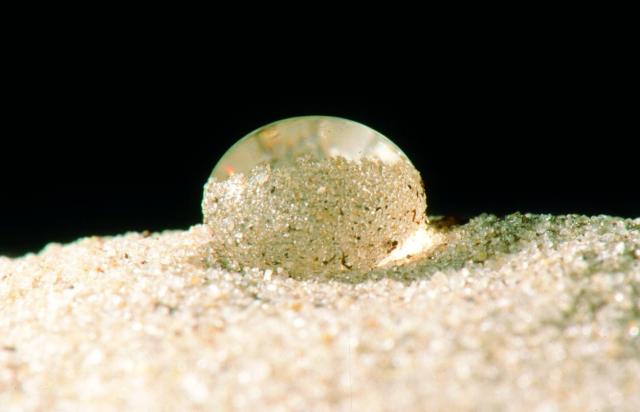The problem with sandy soils
Most home gardens in the metropolitan area of Perth are located on deep, sandy soils. These sands have low fertility, poor moisture and nutrient retention, and are at times non-wetting and water-repellent. Some of these soils may also be too acid or alkaline for the healthy growth of plants. Some native species like Banksias and Grevilleas have adapted to the poor sands, but many non-native species, particularly ornamentals, fruit trees and vegetables, grow poorly unless soils are improved.
If plants struggle, due to poor soil structure or nutrient deficiencies, their natural immune systems are weakened and they become more susceptible to pest and disease attacks.
Poor drainage and aeration, due to soil structural problems, can lead to a build-up of harmful fungal soil diseases which attack garden plants.
Water repellency may lead to uneven water penetration into the soil and dry patches in lawns.
Materials that improve moisture and nutrient retention, soil pH and overcome water repellence are known as soil conditioners.
Improved soils not only provide a good medium for plant growth, they can save on requirements for additional nutrients and water, saving not only money but also off-site impacts on the environment.
Key soil issues and options for treatment
The soils of the coastal plain, although usually sandy at the surface, vary considerably in properties throughout the profile. Sandy soils over limestone near the coast may, for example, require different treatments than sandy soils over clay near the hills.
The information on this page provides general guidance on treatment options, although it may be necessary to consult a soil specialist in your area if your soil issue is difficult to treat.
Retaining water and nutrients
Sandy soils typically drain readily and hold little water. Sandy soils are also inherently infertile and contain (and retain) few of the essential nutrients applied in fertilisers.
Improving the water and nutrient holding capacity of your soil provides significant benefits to plants, decreases watering requirements, and reduces leaching of nutrient into groundwaters and the environment.
Water and nutrient retention may be improved by adding the following:
Organic materials
Organic materials such as compost, coco peat, and composted animal manure will help improve the soil’s ability to hold water and nutrients. Be careful - some of these materials may be water-repellent when dry.
Incorporating green or dry plant residues can also improve the organic matter content of the soil and its water-holding capacity. Before planting anything following the incorporation of plant residues in the soils, make sure the organic material is well broken down. Undecayed organic material may cause Rhizoctonia disease in new plants.
Finer mineral particles
Adding finer mineral particles such as clay, loam and red mud can help both water holding and nutrient holding characteristics of the soil. The aim is to lift the clay content of the soil to about 5-10%. For example – if your soil contains 2% clay (which is a common level for topsoils around Perth) incorporating 10kg per square metre of a product containing 50% clay would achieve a ~5% clay content to a 10 cm depth.
Water-absorbent gels
These gels are small polymer crystals that are designed to absorb 30-1000 times their own weight in water, and when added to a soil can improve its ability to hold water. Rehydrate the crystals before mixing through the potting medium of container plants.
Other additives
Natural minerals such as spongolite, zeolite, vermiculite and perlite may improve water-holding and nutrient retention, although their efficacy will depend on the quality of the material, soil type and rates of application. Expert advice on the applicability of these materials for your area is recommended.
More on nutrients
Clay, loam and peat can retain the essential nutrients potassium, calcium, magnesium, iron, manganese, copper and zinc but have limited ability to retain phosphorus or sulphur.
Minor nutrients need only be applied once or twice a year whereas nitrogen, phosphorus and sulphur need to be applied more frequently during the plant growing season. Nitrogen is easily lost from soils, particularly with over-watering.
Controlled release fertilisers are an effective way of providing nutrients to plants over a long period.
Water repellence
The organic component in Western Australian sandy soils is commonly water-repellent because when organic matter breaks down it leaves a waxy coating on the soil. The simplest way to improve water take-up by hydrophobic soils is to use a soil wetting agent. These are sophisticated detergents and overcome the waxing coating and allow water to penetrate into the pore spaces between the soil particles.
Water repellence is only apparent when the soil is dry. Any treatment must aim to improve the re-wetting properties of the soil. Possibilities include:
- Treating affected areas with a wetting agent, available at hardware and garden stores
- Adding fine mineral particles like loam or clay. Kaolin clay appears to be most effective, but bentonite clays (calcium bentonite preferred over sodium bentonite) may also assist. Incorporating about 5% clay into the top 10cm of the soil will improve the wetting properties in the soil as well as improving the water and nutrient-holding ability.
Soil acidity and alkalinity
Soil acidity and alkalinity are described using the pH scale which ranges from 1 to 14. Acid soils have a pH less than 7, and alkaline soils have a pH greater than 7. Soils with a pH of 7 are called neutral.
pH is determined by using a pH indicator kit (commonly available at nurseries and hardware stores), or a 1:5 soil:water suspension or a 1:5 soil:0.01M calcium chloride suspension. Values of pH in calcium chloride are usually 0.5–0.9 less than those in water. Both methods give similar results.
The pH range on soils around Perth is quite large – from 4-8.5 with the most acidic (pH 4-5) applying to the peaty soils in low-lying swampy areas. The higher pH soils are located on a narrow strip along the coast, where the sands are composed of shell particles.
Whether a soil is acidic, neutral or alkaline affects the availability of essential nutrients, the concentration of toxic elements such as aluminium and manganese, and the activity of micro organisms. These factors all directly or indirectly affect plant growth. At a pH below 5, plant growth may be affected by aluminium and/or manganese toxicity, and molybdenum deficiency. At a high soil pH, the essential plant nutrients, iron, manganese, copper and zinc may be in short supply.
Most plants grow best in the pH range 5.5-7.5. Some species such as gardenias and azaleas require acidic conditions (pH around 5-6), while others such as carnations only grow well under alkaline conditions. Where it is desired to grow these species on soils outside the plant’s preferred pH range, liming or acidification is necessary. Most gardeners choose to grow plant species well adapted to the pH of their garden soil and grow plants needing specific soil conditions in a pot.
Soil acidity can be overcome and pH raised by applying lime, usually as garden or agricultural lime, which is fine-crushed limestone. Where magnesium is also low, dolomite can be used.
The quantity of lime required varies, but as a rule of thumb it can be assumed that 200g per square metre of fine-crushed limestone will increase the pH by one unit. The lime should be applied several weeks before planting and thoroughly mixed with the soil. Frequent watering will speed the neutralising process.
Liquid lime and liquid dolomite can be used to correct acidic soils and work more quickly than dry products. It is necessary to be careful when calculating the amounts of these products required, as often too little is added.
Over-liming should be avoided as it can lead to deficiencies of the essential elements, iron and manganese. Home gardeners contemplating liming may find it helpful to purchase a portable pH kit.
Alkaline soils reduce the availability of iron, manganese, copper and zinc. In most cases these elements can be supplied, but in the long term it may be more expedient to lower the pH.
Common soil conditioners or ameliorants to lower soil pH include mineral sulphur, iron sulphate and aluminium sulphate (Alum). These materials should be thoroughly mixed with the soil and well watered. Recommended application rates are supplied with the product.
Unfamiliar pests
The Department of Agriculture and Food, Western Australia (DAFWA) is on the lookout for animal and plant pests, diseases and weeds that could pose a threat to agriculture and the environment.
If you discover something unfamiliar, please send a photo to DAFWA's Pest and Disease Information Service (PaDIS) at the contact details below.
Please read the sending samples for identification web article before sending, or bringing in, samples to PaDIS, located at 3 Baron-Hay Court, South Perth, 6151, WA.


